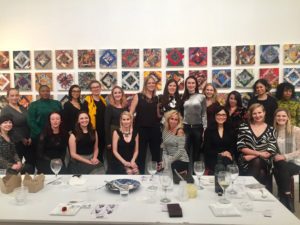In early 2006, right after an unprecedented response to Hurricane Katrina, a change in leadership, and deep budget concerns, the chair of the American Red Cross Board, Bonnie McElveen-Hunter, proposed a bold idea to begin an annual women’s giving program with an ask of $10,000 per year. This proposal was met with incredulity – how could this move fix the budget issues or address the media scrutiny? How much would women give anyway?
At the time, $1,000 was a major gift, and most giving was sporadic and disaster-related rather than regular annual giving for chapter needs. Bonnie persevered, as she knew the American Red Cross needed an annual fundraising program — and she knew that the impact of the Red Cross in local communities would resonate with women donors.
Despite doubts, the bold idea moved forward and the Tiffany Circle was born. In the first year, eight selected chapters piloted how to identify and ask 100 women to donate $10,000 each for needs in their local communities. The outcome of this intentional focus on women and a bold ask was beyond anyone’s imagination. The Tiffany Circle far surpassed its original $1M goal, raising $3 million that first year from 238 members. By 2018, the Tiffany Circle included 858 members, raised $11.6M that year (many giving far more than $10,000), and influenced $34.5M in additional Red Cross donations from their networks. Nearly 25% of all members sat on Red Cross leadership boards.
Guided by the leadership of Bonnie McElveen-Hunter and other women leaders who eagerly volunteered, the American Red Cross took the first step and moved forward without knowing all that would unfold. This is an example of my 5th Principle for successful, sustained women’s philanthropy: Starting Reveals the Path Forward.
Successful organizations realize that they are creating something new with few precedents so they start with a first initiative. They know that the success of their first women’s philanthropy focus then opens up awareness and subsequent choices of ways women’s support will continue to help the mission flourish.
There is no one template for starting a women’s philanthropy initiative. Your institution is unique and so your approach to increase women’s support for your mission will be unique. The first initiatives always start, however, from organizational priorities of the moment as well as leadership champions such as Bonnie McElveen-Hunter.
The key is that institutions committed to begin based on where they were at that moment – their strategies, urgent needs, leadership- and where they could already see early potential results, as Bonnie did for the Red Cross. The Tiffany Circle’s unexpected first success, and the “path forward” that was revealed after the first year, emanated from the release of enthusiasm, connections, creativity and momentum that arise from putting a stake in the ground and beginning. With each subsequent step, the Red Cross learned what they needed to act upon next.
The sustained success from the Tiffany Circle, and the likely success from your own beginning, is about more than money from women. Starting reveals ways to adapt approaches, build different pipelines and communities and bring new faces and input to leadership boards.
Two examples that generated $600,000 and $225 million.
Here are two additional examples of first women’s philanthropy initiatives – different than the American Red Cross in terms of mission, size, and scale – that then opened up so much more than expected:
Example #1: Non profit has unprecedented growth with women partners.
Young Life is a large 75 year old nonprofit Christian ministry serving youth and college students across the United States and over 100 other countries. Young Life leaders realized that women partners weren’t always seeing a place for themselves at the table in the mission and began in 2017 to build multiple ways to invite women to fully participate in the work. A core desire, and strategy, was to engage a community of women in new and innovative avenues of involvement. In 2018 they started by creating seven pilot giving circles in key cities. In each location, 50+ women gathered to give $100 and decide where their pooled money would have impact across the organization. The local giving circles gained traction and grew to involve over 800 women impacting 45 different ministry works throughout the country over the next two years.
That growth birthed a new idea; in 2019 a separate Global Giving Circle was launched. Young Life hoped for 50 women each giving $10,000 to support selected ministries around the world. With less effort than expected, 60 women joined this global community raising over $600,000. Their momentum continued in 2020 despite the pandemic and plans are in place for 100 women to gather in October 2021 to collectively pledge and grant $1 million. Young Life is rapidly creating an environment where women feel they are seen, belong and witness their impact, whether it is through communal giving, or now serving on boards and councils as women’s involvement grows exponentially across the organization.
No one in Young Life leadership could have predicted the variety of these outcomes; they are thriving now because they believed and started.
Example #2: University program cascades from $525,000 the first year, to $225 million over ten years.
Indiana University began its Women’s Philanthropy Leadership Council (WPLC) in 2010 under the leadership of Laurie Burns McRobbie, the wife of the university’s 18th President, Michael A. McRobbie. An inaugural cohort of 35 members giving $15,000 each has impacted the university system-wide in unimagined ways.
The WPLC’s grant making efforts have provided more than $1.6M in funding with partners to innovative projects submitted by IU faculty, staff, and students across the university system since the WPLC’s first grant awards were provided in 2012. Past and active council members have collective given $225M to the university across ten years, attracting many new donors. Past WPLC members have gone on to serve on Dean’s councils, the IU Foundation Board of Directors, and as IU Trustees. A previous chair of the WPLC is now the vice-chair of the IU Foundation Board of Directors, while remaining an active WPLC member.
Overall, WPLC work and outcomes have resulted from a commitment to build a community “characterized by its diversity, its commitment to equity, and its inclusive spirit.” Both the nascent Black Philanthropy Circle and the Queer Philanthropy Circle at IU were inspired by the successful framework of the WPLC.
Planning is important. And at some point, you just have to start.
Organizations that chose to start on their journey to include women in their daily fundraising certainly set and met (or surpassed!) goals for their first initiative, but many did not anticipate how the initiative would grow exponentially, as if the key was finally found to unlock the long-closed room with its treasures inside. Momentum built, women donors gave generously and invited their networks to participate, more funds than expected were raised, more women leaders were invited to be on boards and councils, and now the missions of the institutions thrive.
The American Red Cross started the Tiffany Circle at a most difficult time in their history. Support from women who believe in Young Life grew despite COVID-19. Neither could have predicted their extraordinary and sustained success. What will it take for YOU to start to focus on women?
I knew that women were willing to give; they just hadn’t been specifically asked. So we asked.
Bonnie McElveen-Hunter, Fort Myers Florida Weekly, Jan. 25, 2012.






